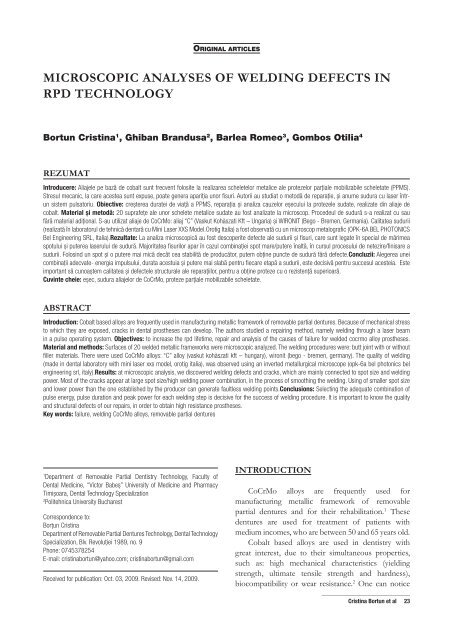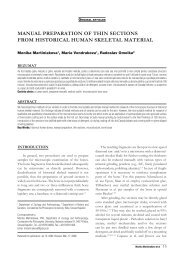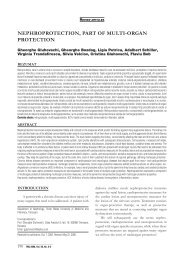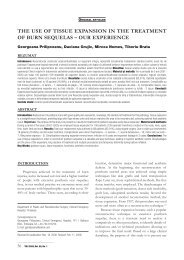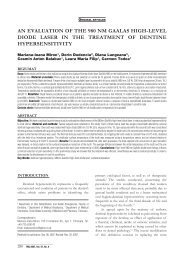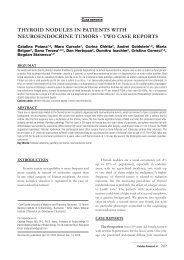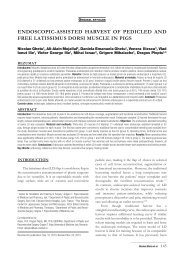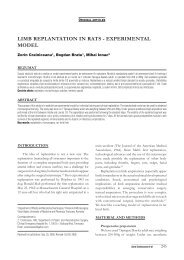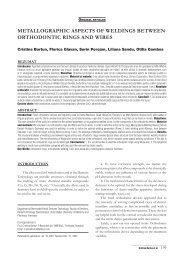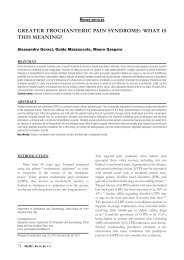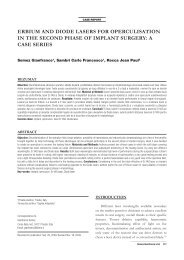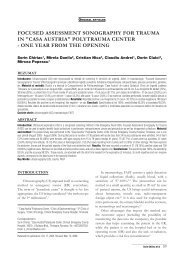microscopic analyses of welding defects in rpd technology
microscopic analyses of welding defects in rpd technology
microscopic analyses of welding defects in rpd technology
Create successful ePaper yourself
Turn your PDF publications into a flip-book with our unique Google optimized e-Paper software.
orIgInal arTIClES<br />
Microscopic AnAlyses <strong>of</strong> Weld<strong>in</strong>g <strong>defects</strong> <strong>in</strong><br />
<strong>rpd</strong> <strong>technology</strong><br />
Bortun Crist<strong>in</strong>a 1 , Ghiban Brandusa 2 , Barlea Romeo 3 , Gombos Otilia 4<br />
reZUMAt<br />
Introducere: Aliajele pe bază de cobalt sunt frecvent folosite la realizarea scheletelor metalice ale protezelor parţiale mobilizabile scheletate (PPMS).<br />
Stresul mecanic, la care acestea sunt expuse, poate genera apariţia unor fisuri. Autorii au studiat o metodă de reparaţie, şi anume sudura cu laser întrun<br />
sistem pulsatoriu. Obiective: creşterea duratei de viaţă a PPMS, reparaţia şi analiza cauzelor eşecului la protezele sudate, realizate d<strong>in</strong> aliaje de<br />
cobalt. Material şi metodă: 20 suprafeţe ale unor schelete metalice sudate au fost analizate la microscop. Procedeul de sudură s-a realizat cu sau<br />
fără material adiţional. S-au utilizat aliaje de CoCrMo: aliaj “C” (Vaskut Kohàszati Kft – Ungaria) şi WIRONIT (Bego - Bremen, Germania). Calitatea sudurii<br />
(realizată în laboratorul de tehnică dentară cu M<strong>in</strong>i Laser XXS Model.Orotig Italia) a fost observată cu un microscop metalografic (OPK-6A BEL PHOTONICS<br />
Bel Eng<strong>in</strong>eer<strong>in</strong>g SRL, Italia).Rezultate: La analiza <strong>microscopic</strong>ă au fost descoperite defecte ale sudurii şi fisuri, care sunt legate în special de mărimea<br />
spotului şi puterea laserului de sudură. Majoritatea fisurilor apar în cazul comb<strong>in</strong>aţiei spot mare/putere înaltă, în cursul procesului de netezire/f<strong>in</strong>isare a<br />
sudurii. Folos<strong>in</strong>d un spot şi o putere mai mică decât cea stabilită de producător, putem obţ<strong>in</strong>e puncte de sudură fără defecte.Concluzii: Alegerea unei<br />
comb<strong>in</strong>aţii adecvate- energia impulsului, durata acestuia şi putere mai slabă pentru fiecare etapă a sudurii, este decisivă pentru succesul acesteia. Este<br />
important să cunoaştem calitatea şi defectele structurale ale reparaţiilor, pentru a obţ<strong>in</strong>e proteze cu o rezistenţă superioară.<br />
Cuv<strong>in</strong>te cheie: eşec, sudura aliajelor de CoCrMo, proteze parţiale mobilizabile scheletate.<br />
ABstrAct<br />
Introduction: Cobalt based alloys are frequently used <strong>in</strong> manufactur<strong>in</strong>g metallic framework <strong>of</strong> removable partial dentures. Because <strong>of</strong> mechanical stress<br />
to which they are exposed, cracks <strong>in</strong> dental prostheses can develop. The authors studied a repair<strong>in</strong>g method, namely <strong>weld<strong>in</strong>g</strong> through a laser beam<br />
<strong>in</strong> a pulse operat<strong>in</strong>g system. Objectives: to <strong>in</strong>crease the <strong>rpd</strong> lifetime, repair and analysis <strong>of</strong> the causes <strong>of</strong> failure for welded cocrmo alloy prostheses.<br />
Material and methods: Surfaces <strong>of</strong> 20 welded metallic frameworks were <strong>microscopic</strong> analyzed. The <strong>weld<strong>in</strong>g</strong> procedures were: butt jo<strong>in</strong>t with or without<br />
filler materials. There were used CoCrMo alloys: “C” alloy (vaskut kohàszati kft – hungary), wironit (bego - bremen, germany). The quality <strong>of</strong> <strong>weld<strong>in</strong>g</strong><br />
(made <strong>in</strong> dental laboratory with m<strong>in</strong>i laser xxs model, orotig italia), was observed us<strong>in</strong>g an <strong>in</strong>verted metallurgical microscope (opk-6a bel photonics bel<br />
eng<strong>in</strong>eer<strong>in</strong>g srl, italy).Results: at <strong>microscopic</strong> analysis, we discovered <strong>weld<strong>in</strong>g</strong> <strong>defects</strong> and cracks, which are ma<strong>in</strong>ly connected to spot size and <strong>weld<strong>in</strong>g</strong><br />
power. Most <strong>of</strong> the cracks appear at large spot size/high <strong>weld<strong>in</strong>g</strong> power comb<strong>in</strong>ation, <strong>in</strong> the process <strong>of</strong> smooth<strong>in</strong>g the <strong>weld<strong>in</strong>g</strong>. Us<strong>in</strong>g <strong>of</strong> smaller spot size<br />
and lower power than the one established by the producer can generate faultless <strong>weld<strong>in</strong>g</strong> po<strong>in</strong>ts.Conclusions: Select<strong>in</strong>g the adequate comb<strong>in</strong>ation <strong>of</strong><br />
pulse energy, pulse duration and peak power for each <strong>weld<strong>in</strong>g</strong> step is decisive for the success <strong>of</strong> <strong>weld<strong>in</strong>g</strong> procedure. It is important to know the quality<br />
and structural <strong>defects</strong> <strong>of</strong> our repairs, <strong>in</strong> order to obta<strong>in</strong> high resistance prostheses.<br />
Key words: failure, <strong>weld<strong>in</strong>g</strong> CoCrMo alloys, removable partial dentures<br />
1 Department <strong>of</strong> Removable Partial Dentistry Technology, Faculty <strong>of</strong><br />
Dental Medic<strong>in</strong>e, “Victor Babeş” University <strong>of</strong> Medic<strong>in</strong>e and Pharmacy<br />
Timişoara, Dental Technology Specialization<br />
2 Politehnica University Bucharest<br />
Correspondence to:<br />
Borţun Crist<strong>in</strong>a<br />
Department <strong>of</strong> Removable Partial Dentures Technology, Dental Technology<br />
Specialization, Blv. Revoluţiei 1989, no. 9<br />
Phone: 0745378254<br />
E-mail: crist<strong>in</strong>abortun@yahoo.com; crist<strong>in</strong>abortun@gmail.com<br />
Received for publication: Oct. 03, 2009. Revised: Nov. 14, 2009.<br />
<strong>in</strong>trodUction<br />
CoCrMo alloys are frequently used for<br />
manufactur<strong>in</strong>g metallic framework <strong>of</strong> removable<br />
partial dentures and for their rehabilitation. 1 These<br />
dentures are used for treatment <strong>of</strong> patients with<br />
medium <strong>in</strong>comes, who are between 50 and 65 years old.<br />
Cobalt based alloys are used <strong>in</strong> dentistry with<br />
great <strong>in</strong>terest, due to their simultaneous properties,<br />
such as: high mechanical characteristics (yield<strong>in</strong>g<br />
strength, ultimate tensile strength and hardness),<br />
biocompatibility or wear resistance. 2 One can notice<br />
_____________________________<br />
Crist<strong>in</strong>a Bortun et al 23
a significant dental alloys’ diversification <strong>in</strong> time, <strong>in</strong><br />
connection with manufactur<strong>in</strong>g technologies. The field<br />
<strong>of</strong> Dental Technology uses especially CoCr alloys, 3-5<br />
which have ISO 22674(2006) guidel<strong>in</strong>es: Type 4- for<br />
dentures with small sections subjected to great forces<br />
and Type 5- for dentures that need a great rigidity and<br />
mechanical resistance, also for RPD. The difference<br />
between these two types is related to the elasticity<br />
conventional limit, which is higher at type 5 (360<br />
towards 500). Knowledge <strong>of</strong> dental alloys’ structure<br />
is necessary <strong>in</strong> order to optimize some cast<strong>in</strong>g and<br />
<strong>weld<strong>in</strong>g</strong> technologies.<br />
In order to reduce the costs and to <strong>in</strong>crease the<br />
dentures lifetime, there appeared the reoptimization<br />
<strong>of</strong> metallic components with help <strong>of</strong> laser <strong>weld<strong>in</strong>g</strong> (the<br />
method <strong>of</strong> comb<strong>in</strong><strong>in</strong>g two materials or assembl<strong>in</strong>g<br />
<strong>of</strong> two materials <strong>in</strong> plastic or fluid phase, through<br />
their local marg<strong>in</strong>al fusion, with or without material<br />
addition, with help <strong>of</strong> optic energy).<br />
_____________________________<br />
24 TMJ 2010, Vol. 60, No. 1<br />
Figure 1. Materials and equipment used for our experiment: a,b. Alloys c.<br />
Weld<strong>in</strong>g equipment; d. Welded RPD Framework; e. Inverted Metallurgical<br />
Microscope OPK-6A BEL<br />
For about 15 years, one can talk about the<br />
advantageous and safe run <strong>of</strong> the laser <strong>weld<strong>in</strong>g</strong> <strong>in</strong><br />
dental <strong>technology</strong>. 6-12 Laser, refused <strong>in</strong> the past because<br />
<strong>of</strong> high costs and lack <strong>of</strong> knowledge, has become<br />
today an aim <strong>of</strong> dental <strong>technology</strong>. The modern lasers,<br />
like those belong<strong>in</strong>g to: BEGO (LaserStar T plus,<br />
LaserStar PW, LaserStar PW LYNX), GIRRBACH<br />
DENTAL SYSTEM (Neolaser L 126500), VISION
INDUSTRY (LWI 4th generation), INTERDENT<br />
Laser System (Herculea), ROFIN-SINAR Hamburg/<br />
Germany (Macro, micro), MANFREDI, have<br />
electronic programm<strong>in</strong>g, <strong>microscopic</strong> visualization<br />
system and laser parameter adjustment, based on the<br />
welded alloy. The <strong>weld<strong>in</strong>g</strong> has maximum stability, gives<br />
a biocompatible zone with mechanic resistance and<br />
can be done very fast, with maximum accuracy, at cold.<br />
Bertrand 6,7 synthesized the advantages <strong>of</strong><br />
laser <strong>weld<strong>in</strong>g</strong>: the <strong>weld<strong>in</strong>g</strong> is done directly on the<br />
cast, which permits a right align<strong>in</strong>g <strong>of</strong> the metallic<br />
framework fragments; it is possible to weld very close<br />
to the acrylic res<strong>in</strong> or ceramic, without any cracks or<br />
color damage; potentially, all metals can be jo<strong>in</strong>ed<br />
but particularly titanium alloys; laser <strong>weld<strong>in</strong>g</strong> jo<strong>in</strong>ts<br />
have a high strength for all metals, consistent with<br />
that <strong>of</strong> the substrate alloy; high mechanic resistance;<br />
reduced thermal <strong>in</strong>fluence, which <strong>in</strong>volves m<strong>in</strong>imum<br />
deformation; it can be used <strong>in</strong> different work<strong>in</strong>g<br />
phases <strong>in</strong> dentures <strong>technology</strong>. If one takes <strong>in</strong>to<br />
account the right adjustment <strong>of</strong> these parameters, one<br />
can obta<strong>in</strong> break<strong>in</strong>g resistance close to or even higher<br />
than that <strong>of</strong> casted pieces.<br />
The estimation <strong>of</strong> welded jo<strong>in</strong>ts quality for some<br />
alloys used <strong>in</strong> dental <strong>technology</strong> can be done us<strong>in</strong>g<br />
destructive and non-destructive methods. Among<br />
the non-destructive methods are: spectrographic,<br />
<strong>microscopic</strong> or radiological <strong>analyses</strong>; metallographic<br />
analysis and micro hardness belong to destructive<br />
methods.<br />
The aim <strong>of</strong> the study was to analyze the causes<br />
<strong>of</strong> failures for welded CoCrMo alloy prostheses,<br />
us<strong>in</strong>g non-<strong>in</strong>vasive, rapid test<strong>in</strong>g methods, like optic<br />
microscopy. The purpose is to <strong>in</strong>crease the use <strong>of</strong><br />
dentures.<br />
MAteriAls And Methods<br />
We have studied 20 removable partial denture<br />
(RPD) metallic frameworks, rehabilitated through laser<br />
<strong>weld<strong>in</strong>g</strong> with or without filler materials (Fig. 1.d). The<br />
<strong>weld<strong>in</strong>g</strong> has been done follow<strong>in</strong>g the Kou 8 specification<br />
from Weld<strong>in</strong>g <strong>in</strong> Metallurgy (2003) manual. CoCrMo<br />
alloys were used, such as: “C” alloy from Vaskut<br />
Kohàszati Kft - Hungary, WIRONIT from Bego<br />
- Bremen, Germany (Fig. 1. a,b). We used a type 4<br />
laser- M<strong>in</strong>i Laser XXS Model Orotig Italia (Fig. 1.c).<br />
The quality <strong>of</strong> <strong>weld<strong>in</strong>g</strong>, made <strong>in</strong> dental laboratory, was<br />
observed us<strong>in</strong>g an Inverted Metallurgical Microscope<br />
OPK-6A BEL PHOTONICS (Bel Eng<strong>in</strong>eer<strong>in</strong>g SRL,<br />
Italia - Fig. 1. e), which has an image capture system<br />
connected to PC.<br />
resUlts<br />
The use <strong>of</strong> metallographic microscope permitted<br />
non-<strong>in</strong>vasive evaluation <strong>of</strong> the <strong>in</strong>vestigated metallic<br />
surfaces. Thus, one can observe different process<strong>in</strong>g<br />
aspects <strong>of</strong> the metallic components (Fig. 2), which are<br />
relevant for prepar<strong>in</strong>g the <strong>weld<strong>in</strong>g</strong> procedure.<br />
After <strong>weld<strong>in</strong>g</strong>, the chemical composition <strong>of</strong><br />
the alloys changes a little- by decrease <strong>of</strong> the basic<br />
components. The alloy becomes harder <strong>in</strong> the welded<br />
zone. In the heat affected zone (HAZ) cracks can<br />
appear, caused by the alloy rapid cool<strong>in</strong>g after <strong>weld<strong>in</strong>g</strong>:<br />
Co from 65% to 64.1%; Cr from 29% to 27.4%; Mo<br />
from 5% to 4.1%.<br />
The CoCr alloys presented a good weldability.<br />
In the first phase we searched the optimal work<strong>in</strong>g<br />
parameters, which were correlated to alloy type, its<br />
chemical composition, fault- crack type, fracture,<br />
the fault size (length and thickness), work<strong>in</strong>g phase<br />
(junction, deposition, smooth<strong>in</strong>g). The adequate<br />
comb<strong>in</strong>ation <strong>of</strong> work<strong>in</strong>g parameters can be customized<br />
with the help <strong>of</strong> <strong>analyses</strong>, for its reproducibility and<br />
practice application. The mechanic resistance <strong>of</strong><br />
welded jo<strong>in</strong>ts depends on the <strong>weld<strong>in</strong>g</strong> spots <strong>in</strong>tegrity.<br />
Thus, we focused on the <strong>weld<strong>in</strong>g</strong> soldered jo<strong>in</strong>t aspect,<br />
on the faults that can appear <strong>in</strong> the <strong>weld<strong>in</strong>g</strong> po<strong>in</strong>ts and<br />
compromise our reparation lifetime.<br />
Choos<strong>in</strong>g <strong>of</strong> optimal parameters for our laser<br />
device is connected to the existence <strong>of</strong> a Nd:YAG laser<br />
with pulsed function<strong>in</strong>g, 25J maximum energy, 6-10A<br />
Input, 1064 nm wavelength; the clearance <strong>of</strong> laser<br />
radiated surfaces and <strong>in</strong>terfaces is compulsory; the<br />
faults that are bigger than 0.2-0.5 mm need addition<br />
<strong>of</strong> a foil or CoCr wire.<br />
Work<strong>in</strong>g parameters for our laser device:<br />
• 8 spot types between 0.3 and 1.8 mm;<br />
• Power <strong>of</strong> the laser pulse 0.5-3 Kw;<br />
• Pulse duration is 0.5-8 msec;<br />
• The radiation diameter no smaller than 1.5 mm<br />
for non precious dental alloys;<br />
• 0.8 mm penetration depth is enough for<br />
obta<strong>in</strong><strong>in</strong>g a good brak<strong>in</strong>g resistance, <strong>in</strong> case <strong>of</strong><br />
long bridges; <strong>in</strong> case <strong>of</strong> higher forces, <strong>weld<strong>in</strong>g</strong> is<br />
done also on the opposite part;<br />
• The superposition <strong>of</strong> successive welded<br />
surfaces has to be 60-70%;<br />
• Pulse frequency no higher than 2 Hz, especially<br />
<strong>in</strong> case <strong>of</strong> small dimension pieces (for example<br />
clasps, precision attachments, <strong>in</strong>dividual milled<br />
attachments);<br />
• One can give up to <strong>in</strong>ert protection gas.<br />
_____________________________<br />
Crist<strong>in</strong>a Bortun et al 25
Figure 2. Aspects <strong>of</strong> RPD metallic surfaces process<strong>in</strong>g (resolution 6 MP,<br />
objective 40X / magnification 400X): a. sandblast<strong>in</strong>g; b. mill process<strong>in</strong>g;<br />
c. polipanto process<strong>in</strong>g; d. polish<strong>in</strong>g<br />
_____________________________<br />
26 TMJ 2010, Vol. 60, No. 1<br />
Laser <strong>weld<strong>in</strong>g</strong> parameters mix<strong>in</strong>g up is a very<br />
complex operation, which depends on alloys<br />
composition, <strong>weld<strong>in</strong>g</strong> procedure, thickness and pr<strong>of</strong>iles<br />
<strong>of</strong> cast samples. In fact, some <strong>of</strong> the macroscopically<br />
faultless <strong>weld<strong>in</strong>g</strong> conta<strong>in</strong>ed hidden pores or cracks,<br />
which compromised the entire jo<strong>in</strong>t. Weld<strong>in</strong>g <strong>defects</strong><br />
and cracks were discovered only at the <strong>microscopic</strong><br />
<strong>analyses</strong>.<br />
Figure 3. Aspects <strong>of</strong> <strong>weld<strong>in</strong>g</strong> spots (power/ time/ frequency) at different<br />
parameters (resolution 6 MP, objective 20X, magnitude <strong>of</strong> the zoom<br />
200X): a. little weld spot 1,6/1,4/1; b. little weld spot 1,7/1,4/1; c.<br />
medium spot: 1,7/1,6/1; d. medium spot ; e,f. <strong>weld<strong>in</strong>g</strong> with filler material<br />
1,9/1,6/1; g. big spot 2/1,7/1; h. big spot 2,1/1,7/1; i,j. fracture <strong>in</strong><br />
<strong>weld<strong>in</strong>g</strong> po<strong>in</strong>t after <strong>weld<strong>in</strong>g</strong> with three variants <strong>of</strong> spots<br />
These <strong>defects</strong> are ma<strong>in</strong>ly connected to spot size<br />
and <strong>weld<strong>in</strong>g</strong> power. So, the use <strong>of</strong> a smaller spot size<br />
and a lower power than the one established by the
producer can generate faultless <strong>weld<strong>in</strong>g</strong> po<strong>in</strong>ts. Most<br />
<strong>of</strong> the cracks appear at a large spot size/ high <strong>weld<strong>in</strong>g</strong><br />
power comb<strong>in</strong>ation, <strong>in</strong> the process <strong>of</strong> smooth<strong>in</strong>g the<br />
<strong>weld<strong>in</strong>g</strong>. When cracks cont<strong>in</strong>ue from one <strong>weld<strong>in</strong>g</strong><br />
po<strong>in</strong>t to another, it generally determ<strong>in</strong>es the break <strong>of</strong><br />
the entire jo<strong>in</strong>t. Therefore, the highest attention is to<br />
be paid for test<strong>in</strong>g a faultless <strong>weld<strong>in</strong>g</strong>.<br />
Figure 3 shows images captured with help <strong>of</strong><br />
metallographic microscope video camera, which<br />
permitted the <strong>weld<strong>in</strong>g</strong> quality evaluation.<br />
In 72% <strong>of</strong> the cases, the cracks were found <strong>in</strong>side<br />
the <strong>weld<strong>in</strong>g</strong> po<strong>in</strong>ts, but at least apparently, not always<br />
affected the weld mechanic resistance.<br />
discUssion<br />
Wulfes, Wataha, 1,4 who have vast experience,<br />
admitted the good weldability <strong>of</strong> CoCr alloys. They<br />
used welded jo<strong>in</strong>ts for the RPD components, with<br />
clasps and also with different precision attachments,<br />
<strong>in</strong>dividual milled attachments. Two thirds coverage<br />
<strong>of</strong> the previous spot is ok. One considers that the<br />
complementary material has to be 45 0 headed towards<br />
the laser beam and the processed object. Also, the<br />
absorption and reflection phenomena <strong>in</strong>fluence the<br />
weld efficacy with chosen parameters. The bl<strong>in</strong>d, non<br />
retro-reflect<strong>in</strong>g surfaces <strong>in</strong>crease the efficiency, while<br />
those retro-reflect<strong>in</strong>g (polished crowns) decrease it. In<br />
order to obta<strong>in</strong> good results, the weld parameter has to<br />
be set for each situation.<br />
Bertrand 6,7 studied 3 alloys for different types <strong>of</strong><br />
dentures; his results showed a maximum penetration<br />
depth <strong>of</strong> 1-2 mm, which represents one <strong>of</strong> the most<br />
usual depths <strong>of</strong> the components that must be repaired.<br />
The surface structure <strong>in</strong>fluences the penetration rate- a<br />
sh<strong>in</strong>y surface decrease laser beam penetration. Because<br />
<strong>of</strong> the laser effect, the weld zone suffered an important<br />
microstructure change- micro hardness <strong>in</strong>creas<strong>in</strong>g.<br />
Craig 2 op<strong>in</strong>ed that, „braz<strong>in</strong>g is a process <strong>in</strong> which<br />
a molten filler metal wets and fills the gap between<br />
the parent metal surfaces. The filler metal has a lower<br />
melt<strong>in</strong>g po<strong>in</strong>t than the parent metal. In <strong>weld<strong>in</strong>g</strong>, the<br />
parent metals fuse and form the jo<strong>in</strong>t with or without<br />
a filler alloy”. When us<strong>in</strong>g filler material, half <strong>of</strong> the<br />
laser beam must fall on the wire, the rest <strong>of</strong> it- on<br />
the parent metal. Thus, we can obta<strong>in</strong> a blend <strong>of</strong><br />
homogeneous molten material. In order to avoid<br />
cracks, pulse duration is reduced. If that is not enough,<br />
one decreases the electric tension and <strong>in</strong>creases the<br />
focal diameter.<br />
Kakimoto Kazutoshi 9 evaluated the laser<br />
weldability <strong>of</strong> 7 dental CoCr alloys. Spot welds were<br />
formed on the surfaces <strong>of</strong> specimens with a pulsed<br />
YAG laser. Observation <strong>of</strong> the microstructure and<br />
the fracture surface suggested that the cracks were<br />
solidification cracks. These cracks were probably<br />
caused by the addition <strong>of</strong> elements, like silicon and<br />
carbon. Although the alloy laser weld had decreased<br />
hardness, neither crack<strong>in</strong>g nor porosity was generated.<br />
The determ<strong>in</strong>er factors for <strong>weld<strong>in</strong>g</strong> quality,<br />
respectively the operator ability <strong>of</strong> choos<strong>in</strong>g the<br />
<strong>weld<strong>in</strong>g</strong> parameters (power, pulse duration, energy)<br />
were <strong>in</strong>vestigated also by Watanabe. 13-15 Regard<strong>in</strong>g the<br />
<strong>in</strong>ert gas atmosphere- argon, there are studies that<br />
show it isn`t absolutely necessary <strong>in</strong> case <strong>of</strong> CoCr alloy<br />
<strong>weld<strong>in</strong>g</strong>.<br />
The same author op<strong>in</strong>e that, <strong>weld<strong>in</strong>g</strong> without filler<br />
material is recommended only if the gap is smaller<br />
than 0.5 mm. Clean<strong>in</strong>g <strong>of</strong> surfaces, their abrasion (2-<br />
3mm) and filler material adjustment, is <strong>in</strong>dispensable<br />
for obta<strong>in</strong><strong>in</strong>g a perfect jo<strong>in</strong>t. The <strong>in</strong>creased thickness<br />
<strong>of</strong> the pieces to be welded has a negative <strong>in</strong>fluence<br />
on the weldability, because a large metallic mass<br />
cause rapid cool<strong>in</strong>g <strong>of</strong> the weld and HAZ, which can<br />
generate fragile structures or even cracks. The big<br />
<strong>in</strong>ternal tensions (result <strong>of</strong> contraction) can lead to<br />
cracks or brak<strong>in</strong>g dur<strong>in</strong>g the function <strong>in</strong> the oral cavity.<br />
Frentzen, Koort, Yamagishi, Neumann and<br />
Dobberste<strong>in</strong> 8,15-17 exam<strong>in</strong>ed the fracture surfaces and<br />
showed that the laser <strong>weld<strong>in</strong>g</strong> technique was much<br />
more effective <strong>in</strong> the peripheral than <strong>in</strong> the central<br />
parts <strong>of</strong> the specimens. The tensile strength <strong>of</strong> the<br />
laser-welded jo<strong>in</strong>ts was significantly lower than that<br />
<strong>of</strong> the brazed jo<strong>in</strong>ts, ma<strong>in</strong>ly due to the smaller crosssection<br />
<strong>of</strong> the welded jo<strong>in</strong>ts and partly due to the<br />
relatively strong brazed jo<strong>in</strong>ts. SEM analysis revealed<br />
localized phenomena, such as pitt<strong>in</strong>g near the jo<strong>in</strong>ts<br />
and pronounced corrosion <strong>in</strong> some <strong>defects</strong> on surfaces.<br />
In case <strong>of</strong> localized corrosion, and over longer periods<br />
<strong>of</strong> time, the process could become autocatalytic and<br />
more pronounced than <strong>in</strong> the study. The laser <strong>weld<strong>in</strong>g</strong><br />
process could be improved by <strong>in</strong>creas<strong>in</strong>g the weld<br />
penetration depth. Preparation <strong>of</strong> the areas to be<br />
welded can reduce laser beam reflection and probably<br />
improve the <strong>weld<strong>in</strong>g</strong> efficiency.<br />
Zupancic et al. 5 op<strong>in</strong>ed that, large jo<strong>in</strong>t surfaces<br />
might ensure sufficient strength and limited thickness<br />
might enable complete jo<strong>in</strong><strong>in</strong>g with m<strong>in</strong>imum porosity.<br />
The longevity <strong>of</strong> RPD frameworks is limited due<br />
to the mechanical or corrosive failure <strong>of</strong> the jo<strong>in</strong>ts.<br />
The purpose <strong>of</strong> their study was to determ<strong>in</strong>e which<br />
jo<strong>in</strong><strong>in</strong>g method <strong>of</strong>fers the best properties for CoCr<br />
alloy frameworks. When laser <strong>weld<strong>in</strong>g</strong> was used,<br />
successful jo<strong>in</strong><strong>in</strong>g was limited to the peripheral aspects<br />
<strong>of</strong> the weld. The <strong>weld<strong>in</strong>g</strong> technique did not affect<br />
significantly the jo<strong>in</strong>t tensile strength. Electrochemical<br />
_____________________________<br />
Crist<strong>in</strong>a Bortun et al 27
measurements <strong>in</strong>dicated that, the corrosion resistance<br />
<strong>of</strong> the laser-welded jo<strong>in</strong>ts was better than that <strong>of</strong> the<br />
brazed one.<br />
Reclaru 3 shows that, precious metal based dental<br />
alloys generally have a superior corrosion resistance,<br />
<strong>in</strong> particular enhanced resistance to pitt<strong>in</strong>g and crevice<br />
corrosion, compared to non-precious metal based<br />
alloys such as CoCr alloys. A new generation <strong>of</strong> Co-Cr<br />
alloys enriched with precious metals (Au, Pt, Ru) have<br />
now appeared on the market.<br />
Burkhardt, Reichert 11,18 compared laser and<br />
microimpulse <strong>weld<strong>in</strong>g</strong>. They concluded that, laser<br />
<strong>weld<strong>in</strong>g</strong> is superior, but more expensive due to the<br />
work<strong>in</strong>g equipment.<br />
conclUsions<br />
Because <strong>of</strong> mechanical stress to which they are<br />
exposed, cracks can appear <strong>in</strong> dental prosthesis. The<br />
repair<strong>in</strong>g method studied by the authors is <strong>weld<strong>in</strong>g</strong><br />
through a laser beam <strong>in</strong> a pulse operat<strong>in</strong>g system. S<strong>in</strong>ce<br />
the cracks that tend to appear do not have a regular<br />
shape, it is highly recommended the use <strong>of</strong> <strong>weld<strong>in</strong>g</strong><br />
by hand.<br />
Laser <strong>weld<strong>in</strong>g</strong> is a perform<strong>in</strong>g method for metallic<br />
prostheses repairs. Select<strong>in</strong>g the adequate comb<strong>in</strong>ation<br />
<strong>of</strong> pulse energy, pulse duration and peak power for<br />
each <strong>weld<strong>in</strong>g</strong> step is decisive <strong>in</strong> the success <strong>of</strong> <strong>weld<strong>in</strong>g</strong><br />
procedure.<br />
It is important to know the quality and structural<br />
<strong>defects</strong> <strong>of</strong> our repairs, both base metal and welded<br />
metal, <strong>in</strong> order to obta<strong>in</strong> high resistance prosthesis.<br />
Microscopically non-<strong>in</strong>vasive <strong>analyses</strong> and tests show<br />
good or poor quality <strong>of</strong> the welded jo<strong>in</strong>ts.<br />
AcKnoWledgeMents<br />
This study was supported by the CNCSIS Grant<br />
Ideas, 1878/2009, from the M<strong>in</strong>istry <strong>of</strong> Education<br />
and Research <strong>of</strong> Romania<br />
_____________________________<br />
28 TMJ 2010, Vol. 60, No. 1<br />
references<br />
1. Wulfes H. Precision mill<strong>in</strong>g and partial denture constructions.<br />
Bremen: Academia Dental 2003.<br />
2. Craig RG. Dental materials: properties and manipulation. 7th Ed. St.<br />
Louis. Mosby 2000.<br />
3. Reclaru L, Lüthy H, Eschler PY, et al. Corrosion behaviour <strong>of</strong> cobaltchromium<br />
dental alloys doped with precious metals. Biomaterials<br />
2005, 26(21):4358-65.<br />
4. Wataha JC. Alloys for prosthodontic restorations. J Prosthet Dent<br />
2002;87:351–63.<br />
5. Zupancic R, Legat A, Funduk N. Electrochemical and mechanical<br />
properties <strong>of</strong> cobalt-chromium. Materials and <strong>technology</strong><br />
2007;6:295–300.<br />
6. Bertrand C, Le Petitcorps Y, Alb<strong>in</strong>gre L, Dupuis V. Optimization<br />
<strong>of</strong> operator and physical parameters for laser <strong>weld<strong>in</strong>g</strong> <strong>of</strong> dental<br />
materials, Br Dent J 2004;196(7):413-8.<br />
7. Bertrand C, Le Petitcorps Y, Alb<strong>in</strong>gre L, Dupuis V. The laser <strong>weld<strong>in</strong>g</strong><br />
technique applied to non precious dental alloys procedure and results,<br />
Br Dent J 2001;190(5):255-7.<br />
8. Frentzen M, Koort HJ. Lasertechnit <strong>in</strong> der zahnheilkunde. DST.<br />
Zahnarzth 1991;46:443-452<br />
9. Kakimoto K, Moriguchi A, Uenishi K, et al. Laser weldability <strong>of</strong><br />
dental cobalt -chromium alloy. J Osaka Odontol Soc 2001;64:35-47.<br />
10. Kou S. Weld<strong>in</strong>g metallurgy, 2nd edition, Wiley Interscience, New<br />
Jersey, 2003.<br />
11. Reichert A. Untersuchung der Schweisnahtqualitaten von Laser und<br />
Phaser Qu<strong>in</strong>tessenz Zahntech 2005;31:264-79.<br />
12. Tambasco J, Anthony T, Sandven O. Laser <strong>weld<strong>in</strong>g</strong> <strong>in</strong> the dental<br />
laboratory: an alternative to solder<strong>in</strong>g. J Dent Technol 1996;3:23-31.<br />
13. Watanabe I, Topham S. Laser <strong>weld<strong>in</strong>g</strong> <strong>of</strong> cast titanium and dental<br />
alloys us<strong>in</strong>g argon shield<strong>in</strong>g. J Prosthodont 2006;15:102-7.<br />
14. Watanabe I, Baba N, Chang J, et al. Nd:YAG penetration <strong>in</strong>to cast<br />
titanium and gold alloy with different surface preparations. J Oral<br />
Rehabil 2006;33:443-6.<br />
15. Yamagishi T, Ito M, Fugimura Y. Mechanical properties <strong>of</strong> laser welds<br />
<strong>of</strong> titanium <strong>in</strong> dentistry by pulsed Nd:YAG laser apparatus. J Prost<br />
Dent 1993;70:264-73.<br />
16. Neumann MO, L<strong>in</strong>digkeit J. Mechanische Festigheit von geschweisten<br />
EMF-Legierungen, Qu<strong>in</strong>tessenz Zahntech 2005;31:966-73.<br />
17. Dobberste<strong>in</strong> H. SchweiBen von kobalt-chrom-, nickel-chrom-and<br />
silber-palladium-legierungen mittles festkörperlaser. Zahn Mund<br />
Kwferheilkd 1990;78:259-61.<br />
18. Burkhardt HJ. E<strong>in</strong> wirtschaftlicher Weg mit Erfolgschancen -<br />
Schweißen mit dem CeHa Phaser MX1. Qu<strong>in</strong>tessenz Zahntech<br />
2005;31(2):136-42.


